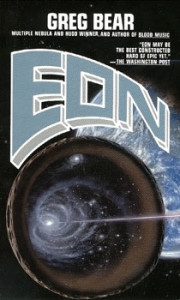 I haven’t read any sci-fi since the 1960’s. After high school, I focused on non-fiction for 40 years to support my career. Now I’m exploring the genre again and Eon was one of the “catch-up” books on my list of hard sci-fi.
I haven’t read any sci-fi since the 1960’s. After high school, I focused on non-fiction for 40 years to support my career. Now I’m exploring the genre again and Eon was one of the “catch-up” books on my list of hard sci-fi.
I was entertained by Eon, especially the first third. It made me remember how much fun it had been in the early days to imagine unfamiliar environments, both physical and social. In this tale, an enormous stone asteroid is in orbit around the Earth, and investigation has revealed that it’s hollow inside, containing the remnants of now-deserted Earthlike cities and agricultural lands. I was quite interested in how such a self-sustaining biosphere could be built and maintained, and curious about what happened to the original inhabitants.
But my interests were never quite satisfied. The author does a lot of hand-waving to account for things, all of it imaginative, none of it compelling. Randomly selected examples:
“’…we don’t know whether the controls are built-in, static, or whether machines are still hard at work someplace.’ In the shadowy halls beyond the light strips on the second floor, she saw man-sized metallic cylinders arranged in rows, marching off into obscurity… ‘I feel like I’m on the Mary Celeste.’ ‘The comparison’s been made,’ Lanier said.” (p. 52)
Cylinders marching off into obscurity? Is that simply the visual perspective effect, or is it supposed to be something else? What are the cylinders for? No explanation is offered, although the author is obsessed with cylindricality throughout the novel.
Later, we find that one of the interior spaces is far larger than the exterior structure, a mathematical puzzle of spatial geometry that is never explained, perhaps because no explanation is possible (the main character is a geometrical mathematician). So again, while the concept is interesting, a container bigger on the inside than on the outside, what’s the point of introducing it without explanation, except for a ‘golly-gee-whiz’ effect?
I found the same superficiality of description to be frustrating even in small things. For example, the main character approaches a chair but finds…”There was something unusual about the chair. A small cylinder was mounted horizontally in the middle of the seat, fitting with some discomfort between her buttocks. There might have been cushions at one time covering the cylinder – or perhaps the chair created its own cushion when powered up.” (p. 53).
Knowing what I do about human buttocks, I simply cannot visualize this chair or how one might sit on it, magical self-created cushions or not. There is no followup on the chair. It has no importance in the scene or the story and I can’t understand why it was ever mentioned. The whole book is like that.
Characters are described with about the same degree of care. Mostly stereotypes, all very similar, their mentality seems universally adolescent and dialog does nothing to develop them. Virtually all dialog performs only narrative exposition, people declaring to each other facts and backstory.
What about dramatic development? There is some, but most of it is derived from cold war politics that prevailed when the book was written (1980’s). The Russian scientists are duplicitous and belligerent and eventually take over the scientific project. Why? Because they’re Russians. No other reason.
Inside the deserted library of the deserted asteroid world, the main character discovers (by waltzing in on her first day and selecting just the right book), that the asteroid is from the future, and that future history says there will be a cataclysmic nuclear war on earth in only two weeks. Nobody saw that coming. Can our heroine use her advanced spatial-geometric mathematics to change the course of history and save the earth? The question is risible.
But even the end is not the end. The story goes on and on and on, with random events, unmotivated actions, unexplained phenomena, twisting and turning until you can’t even remember who the cast members are or what the story line was supposed to be. At least that was my reaction.
This is, or was, a very popular example of hard sci-fi, in which the author stays close to believable or plausible reality as we know it. Credulity can be stretched, as it was severely in this case, but no fairies or dragons are allowed. Cosmological wormholes were all the rage back in the 1980’s so that’s probably why they substitute for magic in this tale.
It was kind of fun to imagine a counterfactual world, but only for a couple of hours. Neither the writing, nor the story itself, were strong enough to justify why I might care about this world. I came away surprised that this is an example of successful hard sci-fi. Of course it is only one book on a long list and maybe not the best choice to start with. Still, I have to say, it isn’t what I expected.
Bear, Greg, (1985). Eon. New York: Doherty, 503 pp.
